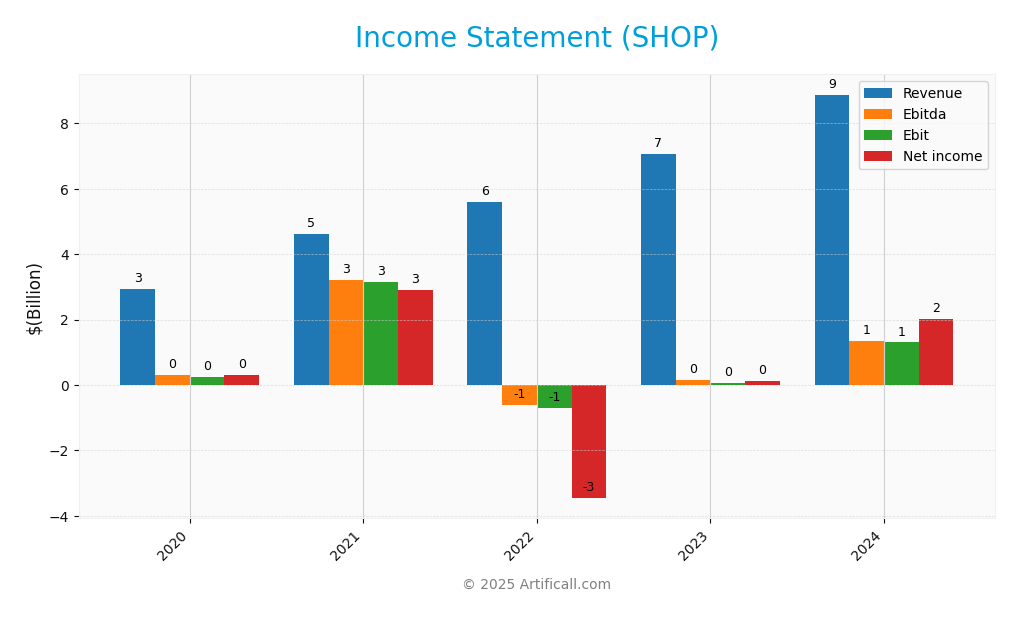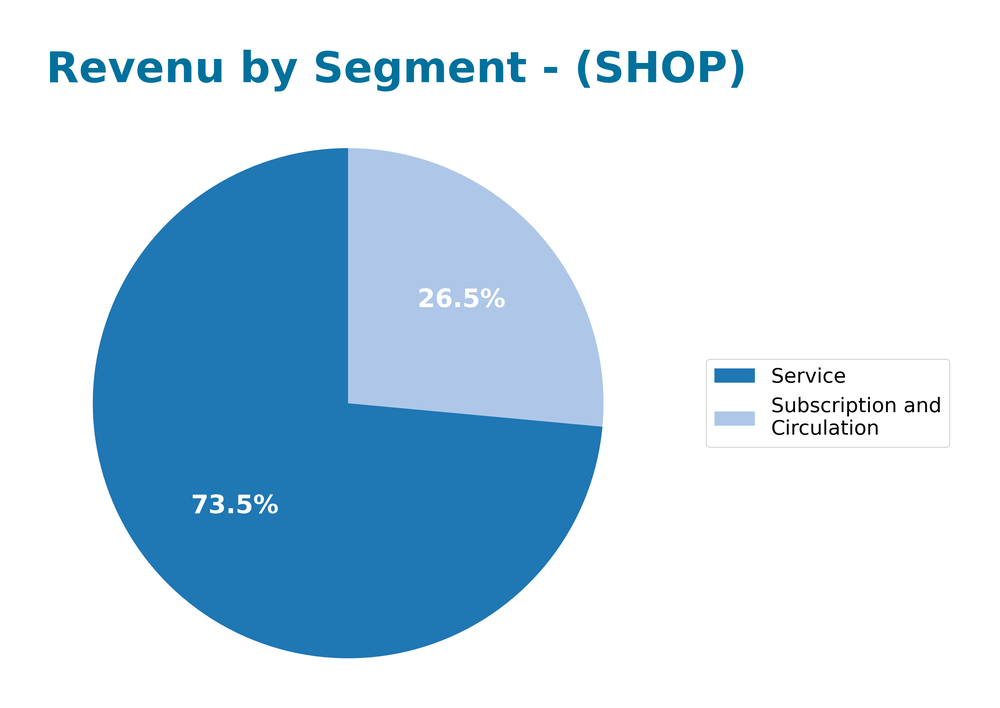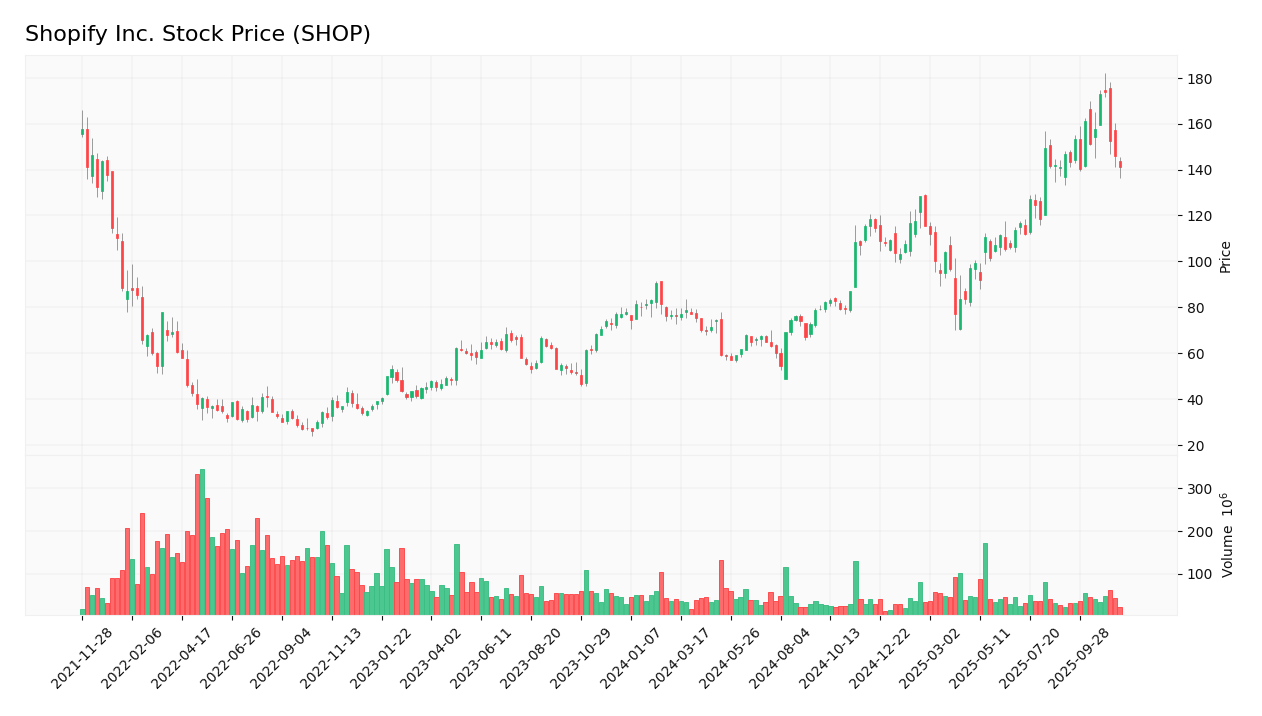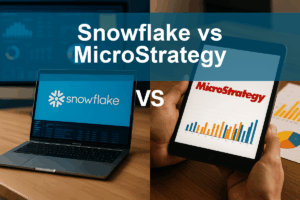Shopify Inc. is redefining the way businesses connect with consumers, empowering entrepreneurs globally to turn their visions into reality. As a frontrunner in the software application industry, Shopify’s innovative platform seamlessly integrates various sales channels, enabling merchants to thrive in an increasingly digital marketplace. With a reputation for quality and cutting-edge solutions, Shopify continues to expand its market influence. As we delve into the investment analysis, I invite you to consider whether the company’s current fundamentals still support its impressive market valuation and growth trajectory.

Table of contents
Company Description
Shopify Inc. is a leading commerce platform that empowers merchants to manage and grow their businesses across diverse sales channels. Founded in 2004 and headquartered in Ottawa, Canada, Shopify operates primarily in North America, Europe, and Asia, providing a comprehensive suite of services that includes payment processing, inventory management, and analytics. With a market capitalization of approximately 192.4B and a workforce of over 8,100 employees, Shopify has established itself as a dominant player in the software application industry. The company’s innovative approach facilitates seamless online and offline sales, positioning it as a key driver of e-commerce transformation and a vital component of the global retail ecosystem.
Fundamental Analysis
This section will analyze Shopify Inc.’s income statement, key financial ratios, and its dividend payout policy to evaluate its financial health and investment potential.
Income Statement
The following table provides a detailed overview of Shopify Inc.’s income statement for the fiscal years 2020 to 2024, highlighting key financial metrics.

| Metric | 2020 | 2021 | 2022 | 2023 | 2024 |
|---|---|---|---|---|---|
| Revenue | 2.93B | 4.61B | 5.60B | 7.06B | 8.88B |
| Cost of Revenue | 1.39B | 2.13B | 2.85B | 3.55B | 4.41B |
| Operating Expenses | 1.45B | 2.21B | 3.58B | 4.93B | 3.40B |
| Gross Profit | 1.54B | 2.48B | 2.75B | 3.51B | 4.47B |
| EBITDA | 319M | 2.41B | -594M | 144M | 1.34B |
| EBIT | 249M | 2.41B | -687M | 74M | 1.30B |
| Interest Expense | 9.56M | 3.46M | 1.15M | 0 | 0 |
| Net Income | 320M | 2.91B | -3.46B | 132M | 2.02B |
| EPS | 0.27 | 2.32 | -2.73 | 0.10 | 1.56 |
| Filing Date | 2021-02-17 | 2022-02-16 | 2023-02-16 | 2024-02-13 | 2025-02-11 |
Interpretation of Income Statement
Shopify’s revenue has shown a robust upward trend, growing from 2.93B in 2020 to 8.88B in 2024, indicating strong market demand and expansion. Net income fluctuated significantly, with a notable loss in 2022, but rebounded impressively in 2023 and 2024, reaching 2.02B. The gross profit margin has remained relatively stable, suggesting effective cost management despite the variations in operating expenses. The most recent year reflects solid growth, driven by increased revenues and improved EBITDA, indicating a strong operational recovery and effective cost control measures.
Financial Ratios
The table below summarizes the key financial ratios for Shopify Inc. (SHOP) over the last few fiscal years.
| Metric | 2020 | 2021 | 2022 | 2023 | 2024 |
|---|---|---|---|---|---|
| Net Margin | 10.91% | 63.20% | -61.79% | 1.87% | 22.74% |
| ROE | 4.99% | 26.18% | -41.99% | 1.46% | 17.47% |
| ROIC | 1.63% | 1.93% | -7.91% | -9.71% | 7.55% |
| P/E | 423.61 | 58.91 | -12.70 | 756.31 | 68.18 |
| P/B | 21.15 | 15.42 | 5.33 | 11.01 | 11.91 |
| Current Ratio | 15.69 | 12.15 | 7.07 | 6.99 | 3.71 |
| Quick Ratio | 15.69 | 12.15 | 7.07 | 6.97 | 3.70 |
| D/E | 0.14 | 0.10 | 0.17 | 0.13 | 0.08 |
| Debt-to-Assets | 11.76% | 9.54% | 12.98% | 10.18% | 8.09% |
| Interest Coverage | 9.43 | 77.60 | -714.78 | – | – |
| Asset Turnover | 0.38 | 0.35 | 0.52 | 0.62 | 0.64 |
| Fixed Asset Turnover | 13.85 | 15.28 | 11.52 | 48.03 | 63.43 |
| Dividend Yield | 0% | 0% | 0% | 0% | 0% |
Interpretation of Financial Ratios
Analyzing Shopify Inc.’s 2024 financial ratios reveals a solid liquidity position, with a current ratio of 3.71 and a quick ratio of 3.70, indicating strong short-term financial health. The solvency ratio stands at 0.87, suggesting manageable debt levels. Profitability is robust, with a net profit margin of 22.74%, although this reflects a decrease compared to previous years. Efficiency ratios like receivables turnover at 5.37 and inventory turnover at 169.54 suggest effective asset management. However, the high price-to-earnings ratio of 68.18 indicates potential overvaluation, raising concerns about sustainability. Overall, while Shopify shows strong fundamentals, investors should remain cautious due to high market expectations.
Evolution of Financial Ratios
Over the past five years, Shopify’s financial ratios have shown significant volatility. While liquidity ratios peaked in 2021, profitability and efficiency metrics have fluctuated, reflecting challenges in maintaining consistent growth and profitability in a competitive environment.
Distribution Policy
Shopify Inc. (SHOP) does not currently pay dividends, reflecting its focus on reinvestment for growth rather than returning capital to shareholders. The absence of dividends allows the company to allocate resources towards research and development and strategic acquisitions. Moreover, Shopify engages in share buyback programs, indicating a commitment to enhancing shareholder value. This approach aligns with long-term value creation, as sustained investment in growth can lead to significant future returns for investors.
Sector Analysis
Shopify Inc. operates in the Software – Application industry, providing a comprehensive commerce platform that empowers merchants globally. Its competitive advantages include robust features, strong brand recognition, and diverse service offerings.
Strategic Positioning
Shopify Inc. (SHOP) holds a significant position in the e-commerce platform market, with a robust market share driven by its comprehensive suite of merchant solutions. As of now, the company faces competitive pressure from emerging platforms and established players, necessitating continuous innovation. The ongoing technological disruptions, particularly in AI and mobile commerce, present both challenges and opportunities for Shopify. With a market cap of $192.4B, maintaining its competitive edge and adapting to these changes is crucial for future growth and market resilience.
Revenue by Segment
The following chart illustrates Shopify Inc.’s revenue distribution across different segments for the fiscal year 2024, showcasing the company’s evolving business landscape.

In FY 2024, Shopify’s revenue reached $6.53B from Services and $2.35B from Subscription and Circulation. Notably, the Services segment is becoming a more significant revenue driver, reflecting a shift in business strategy towards enhancing value-added services. Comparatively, the Subscription segment has shown stability but may face challenges as competition increases. The overall trend indicates a healthy growth trajectory, although I remain cautious regarding potential margin pressures in a competitive landscape, which may impact future performance.
Key Products
Below is a table summarizing the key products offered by Shopify Inc., illustrating their functionalities and benefits for merchants.
| Product | Description |
|---|---|
| Shopify Platform | A robust e-commerce platform that allows businesses to create and manage their online stores across multiple sales channels. |
| Shopify Payments | A secure payment processing solution that enables merchants to accept various payment methods seamlessly. |
| Shopify Shipping | A comprehensive shipping service that offers discounted shipping rates and tools for managing logistics effectively. |
| Shopify POS | A point-of-sale system that facilitates in-person transactions and integrates with online sales for a unified experience. |
| Shopify App Store | A marketplace for third-party applications that extend the functionality of Shopify stores with additional features. |
| Custom Themes & Apps | A range of customizable themes and applications that enhance the visual appeal and performance of online stores. |
| Analytics & Reporting | Tools that provide insights into sales performance and customer behavior, helping merchants make informed business decisions. |
These products collectively empower merchants to effectively manage their e-commerce operations and drive growth in a competitive landscape.
Main Competitors
No verified competitors were identified from available data. However, Shopify Inc. holds a significant position in the e-commerce software market, with an estimated market share of around 20%. As a key player in the Technology sector, Shopify primarily serves merchants globally, providing a comprehensive platform for online and offline commerce.
Competitive Advantages
Shopify Inc. (SHOP) boasts a robust competitive advantage through its comprehensive commerce platform, which supports merchants across multiple sales channels, including web, mobile, and social media. The company’s ability to integrate various functionalities—like payment processing, inventory management, and customer relationship tools—makes it a one-stop solution for e-commerce businesses. Looking ahead, Shopify is poised to expand further into emerging markets and introduce innovative products, such as AI-driven analytics and enhanced fulfillment services, creating new opportunities for growth and solidifying its market leadership.
SWOT Analysis
This analysis provides insights into Shopify Inc.’s strengths, weaknesses, opportunities, and threats to aid in strategic decision-making.
Strengths
- Strong brand recognition
- Comprehensive ecommerce solutions
- Diverse revenue streams
Weaknesses
- High dependency on small merchants
- Limited profitability history
- Regulatory challenges
Opportunities
- Expanding global market for ecommerce
- Increasing demand for digital payments
- Potential for new partnerships
Threats
- Intense competition
- Economic downturns
- Cybersecurity risks
The overall SWOT assessment indicates that while Shopify has significant strengths and opportunities, it must address its weaknesses and be vigilant about external threats. This balanced view can guide Shopify’s strategic initiatives to enhance growth while mitigating risks.
Stock Analysis
Over the past year, Shopify Inc. (SHOP) has experienced significant price movements, culminating in a noteworthy bullish trend with a price increase of 89.73%. This analysis will delve into key price dynamics and trading patterns that have shaped its stock performance.

Trend Analysis
Analyzing the price change over the past year, Shopify’s stock has increased by 89.73%, indicating a bullish trend. However, in the recent period from September 7, 2025, to November 23, 2025, the stock saw a minimal increase of 0.67%. This suggests a deceleration in trend momentum, as the price fluctuation remains within a neutral range. The stock has reached a notable high of 173.86 and a low of 54.43, with a standard deviation of 29.52, reflecting moderate volatility.
Volume Analysis
In the last three months, Shopify’s trading volume totaled approximately 5.57B shares, with buyer-driven activity at 2.92B shares (52.34%) and seller-driven activity at 2.60B shares. However, the overall volume trend is decreasing, which may indicate a softening of market participation. Recent data shows a slight buyer dominance with 57.09% of the latest trades being purchases, suggesting some investor confidence, albeit with reduced overall activity.
Analyst Opinions
Recent analyst recommendations for Shopify Inc. (SHOP) indicate a consensus rating of “Buy.” Analysts highlight the company’s strong return on assets (5) and equity (4), suggesting robust operational efficiency. However, concerns remain regarding its price-to-earnings (1) and price-to-book (1) ratios, which could indicate overvaluation. Notable analysts, including those from leading financial institutions, have emphasized Shopify’s growth potential in the e-commerce sector. Overall, the positive sentiment from analysts reflects confidence in Shopify’s long-term performance despite some financial metrics that warrant caution.
Stock Grades
The latest ratings for Shopify Inc. (SHOP) from reputable grading companies indicate a steady outlook for the stock.
| Grading Company | Action | New Grade | Date |
|---|---|---|---|
| UBS | Maintain | Neutral | 2025-11-05 |
| JP Morgan | Maintain | Overweight | 2025-11-05 |
| Cantor Fitzgerald | Maintain | Neutral | 2025-11-05 |
| Truist Securities | Maintain | Hold | 2025-11-05 |
| Barclays | Maintain | Equal Weight | 2025-11-05 |
| DA Davidson | Maintain | Buy | 2025-11-05 |
| CIBC | Maintain | Outperform | 2025-11-05 |
| Scotiabank | Maintain | Sector Perform | 2025-11-05 |
| BMO Capital | Maintain | Outperform | 2025-11-05 |
| Needham | Maintain | Buy | 2025-11-05 |
Overall, the trend in grades shows a mix of neutral to positive outlooks, with several firms recommending “Buy” or “Outperform.” This suggests that while there is some uncertainty reflected in the neutral ratings, a significant number of analysts remain optimistic about Shopify’s potential in the market.
Target Prices
The consensus among analysts for Shopify Inc. (SHOP) indicates a positive outlook.
| Target High | Target Low | Consensus |
|---|---|---|
| 200 | 140 | 181.2 |
Analysts expect Shopify’s stock to reach a consensus price of 181.2, reflecting a bullish sentiment in the market.
Consumer Opinions
Consumer sentiment towards Shopify Inc. (SHOP) reflects a mix of enthusiasm and caution, as users weigh the platform’s strengths against some notable weaknesses.
| Positive Reviews | Negative Reviews |
|---|---|
| “Shopify’s ease of use has transformed my business!” | “Customer service can be slow to respond.” |
| “The wide range of apps allows for great customization.” | “Transaction fees can add up quickly.” |
| “Excellent support resources and community.” | “Some features feel limited for larger businesses.” |
Overall, consumer feedback on Shopify indicates strong appreciation for its user-friendly interface and customization options, while concerns about customer service responsiveness and transaction fees frequently arise.
Risk Analysis
In evaluating Shopify Inc. (SHOP), it is essential to consider various risks that could impact its performance. Below is a summary of the key risks associated with the company.
| Category | Description | Probability | Impact |
|---|---|---|---|
| Market Risk | Fluctuations in e-commerce demand affecting sales. | High | High |
| Competition | Intense competition from other e-commerce platforms. | High | Medium |
| Regulatory Risk | Changes in regulations affecting online businesses. | Medium | High |
| Technological | Rapid advancements requiring constant adaptation. | Medium | Medium |
| Cybersecurity | Threats from data breaches and cyberattacks. | High | High |
The most critical risks for Shopify include high market and cybersecurity risks, as the e-commerce sector remains vulnerable to economic fluctuations and increasing cyber threats.
Should You Buy Shopify Inc.?
Shopify Inc. has demonstrated a positive net margin of 22.74% and a strong revenue growth of 32.68%. The company’s debt levels are relatively low, with a debt-to-equity ratio of 0.097, indicating a moderate financial risk, while its rating stands at B, reflecting a generally favorable outlook.
Favorable signals The company has a positive net margin, demonstrating profitability. The total debt is low relative to equity, which suggests manageable financial risk. Additionally, Shopify’s strong revenue growth of 32.68% indicates robust demand and operational efficiency.
Unfavorable signals The return on invested capital (ROIC) stands at 7.55%, which is below the weighted average cost of capital (WACC) of 16.86%. This situation implies value destruction, as the company is not generating sufficient returns on its investments to cover its cost of capital. Furthermore, the price-to-earnings ratio (PER) is 68.18, indicating the stock may be overvalued.
Conclusion Given the presence of a positive net margin and revenue growth, but also considering that ROIC is below WACC, I might suggest a cautious approach. It would be prudent to wait for more favorable conditions before making any investment decisions.
However, the high PER indicates that the stock is overvalued, and the lack of growth in net income raises a risk of correction.
Disclaimer: This article is not financial advice. Each investor is responsible for their own investment decisions.
Additional Resources
- Investors Heavily Search Shopify Inc. (SHOP): Here is What You Need to Know – Yahoo Finance (Nov 21, 2025)
- Providence Wealth Advisors LLC Acquires Shares of 1,750 Shopify Inc. $SHOP – MarketBeat (Nov 23, 2025)
- SHOP – Shopify Inc Stock Price and Quote – Finviz (Nov 21, 2025)
- Shopify Inc Stock Price Today | NASDAQ: SHOP Live – Investing.com (Nov 04, 2025)
- Shopify Beats Across the Board: Q3 Shows Growth, Efficiency, Brand Wins – Shopify (Nov 04, 2025)
For more information about Shopify Inc., please visit the official website: shopify.com



